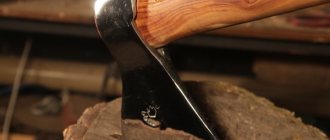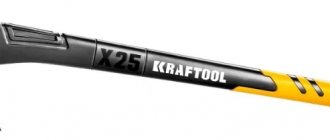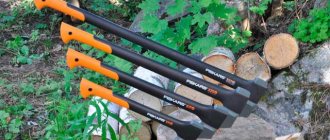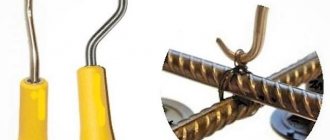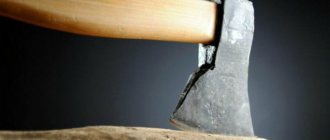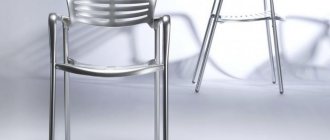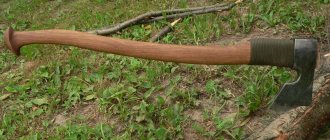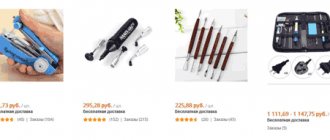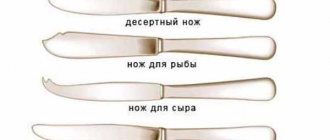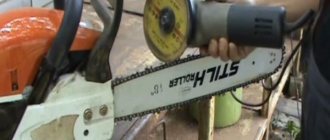Design and types of product
The design of the ax has changed little over the millennia. The design of all varieties includes the following parts:
- steel blade with a spine;
- wooden or plastic handle - ax handle;
- metal or wooden wedges or other system for attaching the blade to the handle.
The blade is made from high-quality tool alloys with a carbon content of more than 0.7%.
According to their purpose, the following types of axes are distinguished:
- Plotnitsky (universal). The main purpose is carpentry work, but with such an ax it is possible to fell a small tree and chop firewood
- Cleaver. The purpose of a heavy tool with a long handle is to chop wood in large volumes. The shape of the blade prevents it from getting stuck in the log.
- Lumberjack. Optimized for logging: tree felling and delimbing. Weighs up to 2 kg.
- Tourist. Lightweight, small-sized hatchet for universal use. Purpose: to chop dead wood, spruce branches for overnight stays, tent stakes, etc.
- Multifunctional. The butt is made in the shape of a pickaxe, hammer head, or nail puller. Used by roofers and concrete workers, amateur builders for limited volumes of various works.
Carpenter's ax
Tourist ax
There are also highly specialized varieties - for cutting meat carcasses, fire engines, used in historical reconstructions, etc.
How to choose an ax knife?
The correct choice of hatchet knives is based on several important parameters.
- The blade should be wide and thick. The optimal balance between weight and force applied to cutting is the main criterion when choosing a knife with the most effective and easy-to-use blade. The length of the blade is most often 15-25 cm, but the width must be at least 8 cm, otherwise it is no longer a cleaver, but an ordinary kitchen knife.
- A shortened handle with a transversely rounded shape, with depressions for holding the entire structure with your fingers. This allows you to achieve the most reliable coverage, significantly reducing hand fatigue during work.
- Double-sided sharpening. A one-sided one will move the tip to the side, which is why cutting the product will require noticeably more effort. Sharpening a dull blade on both sides is easier - you will still sharpen the knife not one-sided, but double-sided. The sharpening angle must not go beyond 15-45 degrees: a larger one interferes with cutting meat, while a smaller one makes the knife unusually thin, like a razor blade.
- The quality of the steel must be stainless, not carbon. The latter becomes covered with a brown coating when the knife is not immediately washed, quickly becomes thinner, it is increasingly difficult to make it sharp again when it becomes dull from frequent bones, and the food tastes like iron. Rusting products are cheap, but don't skimp on the price. Damascus steel or titanium are quite durable, the first requires special care, the second, on the contrary, is unpretentious to use and noticeably lighter.
- The best choice would be a metal handle rather than a wooden or plastic one. The metal will not burn or melt from high temperatures, for example, when a knife is accidentally thrown dangerously close to a fire. The all-steel product is easy to clean and does not retain foreign odors. A solid knife does not require rivets or bolts. Disadvantages: decent weight (more than a kilogram) and high price.
- Finally, before purchasing a hatchet knife, check it for quality: absence of wear (numerous abrasions and scratches, indicating that the tool has been used for a very long time and has been sharpened several times), chips, gouges and notches. The latter report that the knife was not used at all for its intended purpose, for example, by hitting the butt with a hammer, pieces of wood were split into splinters.
Review of Mr. cutting hatchet Blade Camp awaits you next.
What determines the method of sharpening an ax
It is possible to sharpen a tool using several methods, giving the tip different shapes and angles. The choice of method is determined by the following parameters:
- Type of wood processed. Stiffness, length and orientation of fibers, their twist, general knotiness.
- Wood moisture content. To split wet wood, a large blade entry depth is required.
- Type of work to be done. To trim a log, a sharper angle is required. To chop firewood, the slope must be greater.
- The steel from which the blade is made. A stronger one is more difficult to sharpen, but it will also keep its edge longer.
No less important parameter than the angle is the width of the chamfer (for trimming logs or bevels). It should be sufficient so that the ax fits well into the tree and does not bounce off it.
Blade shapes
On new tools, the ax is usually sharpened at the desired angle and with a good chamfer width. If the tool works, the bevels will have to be updated.
The main parameters of proper sharpening
An ax that has been successfully sharpened can cope with any task.
When sharpening, it is important to take into account the design features of this tool, in the future to minimize the expenditure of physical force during the work process. In addition, the choice of the main parameters and method of sharpening an ax for cutting trees depends on:
- Features of the wood being processed. The presence of knots, curls, cross-layers, cracks and other defects. You should also evaluate the moisture content of the wood. Water-saturated fibers require a deeper blade entry to split.
- Specifics of work. Cutting wood, trimming fibers, splitting wood - all these are different technological processes that require different equipment in the working area of the tool.
- Blade material. The higher the grade of steel, the higher its strength characteristics. It will take a lot of effort to sharpen such a blade, but it will also maintain its sharpness longer without being subject to deformation.
Options for ax sharpening angles
The sharpening angle required for an ax blade depends on the functionality of the tool. A cleaver intended for cutting wood requires sharpening the blade at an angle from 40° to 60°. For general construction, carpentry and special work, a universal sharpening angle of 30°-35° is suitable. For trimming, planing and finishing wood, the sharpness of the blade must be ensured by a sharpening angle of 20°.
GOST provides for the selection of the sharpening angle of the cutting blade in accordance with the mechanical properties of the wood being processed. For soft wood the angle is sharper, and for dense and hard wood it is obtuse.
Ax chamfer width
The width of the chamfer is as important a parameter as the sharpening angle. Its parameters must be sufficient to ensure high performance properties of the tool.
The bevel width is the axial length from the blade to the blade. The shorter this distance, the higher the performance of the ax. The optimal chamfer width is considered to be 1-2 mm. If the quality of the steel from which the working part is made does not meet the strength parameters, then the chamfer shape is asymmetrical.
The service life of the ax before new sharpening depends on the chamfer parameters, so it is better to make a chamfer of individual sizes for each type of work.
The process of sharpening an ax
Sharpening an ax properly requires attention and concentration.
You will need:
- a set of abrasive stones with different grains;
- a piece of rough cloth;
- measuring stick or protractor;
- water;
- The belt is usually made of genuine leather.
First you need to measure the current sharpening angle. This is done by applying a measuring block. The block is made with a bevel equal to the angle at which you decide to sharpen the tool.
to sharpen an ax, place it on a flat base (table, stool) and begin to draw a block along the blade, describing half rings. The block should be held at a sharpening angle. Coarse abrasive is used to restore the required slope and width of the chamfer. The operation is repeated on the other side of the blade.
Next, you should take a block with a medium grain and sharpen it on both sides. And finally, it’s the turn of the third, smoothest sharpener - it is used to remove burrs and the smallest irregularities. The surface of the chamfer should be smooth to the touch.
Attention! You should check the surface by running your finger only from the butt to the tip.
The testamentary operation is editing on a tense leather belt.
During work, the ax and abrasive bars must be moistened with water. Dust and small metal particles are removed with a piece of cloth.
During initial sharpening and in cases where the ax has become very dull, experts recommend removing it from the ax handle. And the tilt will be easier to maintain, and the handle will not get in the way.
Professionals use special sharpening devices - electric sharpening machines. There are adjustable stops for the sharpened tool, allowing you to sharpen it at a given angle.
Correct tool sharpening technology
The technology for sharpening a professional meat ax is practically no different from a similar procedure for other piercing and cutting tools (Figure 5).
To carry out the procedure correctly, you must consider the following:
- The work area must be properly equipped. The sharpening tool must be firmly installed on the bed, and the bed must be attached to the floor so that it does not move during operation.
- Before starting work, carefully inspect the abrasive wheel: it must be absolutely smooth, without beating or nicks. Only in this case will you be able to sharpen it technologically correctly and without harm to the blade.
- Take care of personal protective equipment as well. First of all, you need to put on safety glasses. Kitchen hatchets are made of high-quality steel, and during the sharpening process, metal splashes and abrasive dust can fly in all directions and accidentally get into your eyes.
- The sharpening technology itself is as follows: the blade is held in the direction “away from you” towards the rotation of the circle and parallel to its axis. It is advisable to hold the ax with both hands so that you can accurately maintain the sharpening angle.
- During the process, try not to overheat the cutting edge. As a result, the steel of the blade may become too brittle and will crumble during further use.
Figure 5. Correct sharpening technology
If during sharpening you notice that a burr has accidentally formed on the blade, do not despair. This does not mean that the instrument is damaged. To correct the situation, simply turn the ax over and start sharpening it in the other direction. It is better to bring the cutting edge to the desired condition on a small abrasive wheel
At this stage, extreme care must be taken so that the edge of the chip does not break off, and the edge itself remains strong. To do this, it is best to use the double sharpening method.
At the final stage, you can check the sharpening angle of the blade using special templates and, if necessary, bring the product to perfection.
Ax sharpening angles
The sharpening angle of the ax is chosen based on the characteristics of the work to be done. To trim logs or posts, you need to sharpen a very sharp angle - up to 20°.
The slope of the bevel for the cleaver is selected based on the mechanical properties of the wood. For fragile spruce it can be smaller, but for very dense and hard acacia, on the contrary, it can be blunter.
Sharpening angle
Precision work - for example, selecting grooves and tenons - is performed with an angle of 15-20°. This value makes it possible to carry out both preliminary rough processing and fine adjustment of the part to a given size.
Preliminary preparation
Before you sharpen an ax, you need to determine how sharp it needs to be. The latter depends on the angle of inclination - the smaller the angle, the sharper the blade.
The choice of a specific sharpening angle for an ax depends on the following nuances:
- What kind of wood will you have to work with? Its type and humidity are important (the damper the wood, the deeper the ax should go).
- Specifics of work: for trimming logs you will need an acute angle, for splitting - a large slope.
- Type of metal. The stronger the metal, the more difficult it is to sharpen, but it will also stay sharp longer.
The main parameters that determine the sharpness of the tool are the sharpening angle and the width of the chamfer. The last parameter is not easy to change: to do this, you need to remove excess metal from the sides.
The sharpening angle depends on the specific work:
- For trimming a small workpiece, a small angle, about 15-20 degrees, is suitable;
- For splitting logs and other household work, 25-30 degrees is enough;
- A carpenter's ax is sharpened to 35 degrees;
- For chopping logs and cutting small trees, use a heavy tool with a blunt blade, up to 40 degrees.
Sharpening with a machine Source blogspot.com
See also: Catalog of companies that specialize in complex installation of internal engineering systems
The stronger the wood you are working with, the duller the blade should be. Most often, the angle of inclination is chosen by the manufacturer, change it
To choose how to sharpen an ax correctly, you should pay attention to the type of blade. According to their appearance, blades are divided into:
- Straight: The sides go straight. Such axes are used for rough work: hewing or chopping.
- Oval (wedge-shaped): The sides seem to be slightly concave outward, the blade appears oval. This is a universal option; it is used for removing the top layer from wood, leveling and other work.
- Razor: the sides are curved inside, the blade is sharper. Such blades are found on fire axes and butcher axes, that is, on more specialized tools.
Usually the blade already has a certain shape that does not need to be corrected.
Ax chamfer width
The width of the chamfer corresponds to the distance from the axis of the blade to its side surface. This parameter determines both the sharpness of the tool and the service time until the next sharpening. Sharpening an ax with the correct bevel is quite quick and easy.
Correcting the dimensions of the chamfers is a more complex operation and will require a lot of time and effort. To change the width of the chamfers, it is necessary to remove excess metal.
Historically, axes damaged by long work or corrosion, which had lost part of the metal in the chamfer area, were restored by a blacksmith using the method of partial reforging. The weight and dimensions became smaller, but the geometric parameters and functionality of the instrument were restored; it was enough to sharpen it again.
Double beveled ax
Axes made from low quality metal wear out quickly and lose their bevel shape. In this case, you should sharpen the tool asymmetrically: - one chamfer is made at 15°, and the other at 25°.
At what angle should I sharpen?
The angle of the ax at which it needs to be sharpened is determined depending on the functionality of the device. For example, if you plan to trim pillars or logs, you will need a fairly sharp angle - approximately 20 degrees. Grooves and tenons, like other tasks requiring filigree work, are performed at an angle, the value of which ranges from 15 to 20 degrees. This choice, by the way, will also allow pre-processing. As for the bevel of the cleaver, its inclination depends on the type of wood being processed.
Typically, the denser the wood, the steeper the slope. A variety of universal work can be carried out with an ax angle of 25 to 30 degrees. The smaller the angle at which the ax , the sharper its blade will be. The sharper the blade, the easier it is to use, but the faster it will fail. In addition, an overly sharpened blade increases the likelihood that it will get stuck in the wood and will have to be pulled out with some physical effort.
It is important to mention that the edge of the cutting blade can be of the following types:
- oval - suitable for tools with which trees are split or partially trimmed;
- razor - allows you to perform more delicate work, for example, a figured cut;
- wedge-shaped - considered universal, it makes it possible not only to chop firewood, but also to remove the top layers of wood and even slightly level the surfaces; It is an ax with a wedge-shaped edge that is recommended to have in the household.
Sources:
https://stroy-podskazka.ru/topory/kak-zatochit/
Standard errors
There are several common mistakes when sharpening:
- Overheating of the material when working on an electric grinder. This leads to a change in the internal structure of the steel and, as a consequence, to a loss of strength and elasticity. At the same time, the wear resistance, sharpness and other performance qualities of the tool are significantly reduced. To avoid overheating, you need to periodically moisten the abrasive with water or other coolant.
- An attempt to sharpen an ax on a grinder. When holding the grinder in your hand, beating cannot be avoided, and the blade will constantly move to the side. In such conditions it is impossible to talk about observing any angles. Here it would be nice to just hold in your hands a dangerous tool that is flying to the sides. Attaching an angle grinder to the machine will improve the process, but not much. The problem of lateral slip will not go away.
- The desire to sharpen a blade on old equipment with a worn-out sharpening wheel. Axial runout and unevenness of the abrasive surface will not allow you to sharpen the ax efficiently, in compliance with the required angles and width of the chamfers.
It is better to spend more time sharpening the tool by hand than to use low-quality or unsuitable equipment.
Briefly about the main thing
In the household, an ax is one of the most popular tools. Its sharpening depends on the type of metal, type and shape of the blade, purpose and other nuances.
Sharpening can be done manually with a whetstone or using an electric sharpener. In the first case, the work will go slower, but the process is easier to control.
An electric sharpener will allow you to do the work faster and better, but it must be in full working order, and the grinding wheel must be new. It is not recommended to use a grinder - it can be dangerous for humans and harmful for the ax.
In order for the tool to serve for a long time, it is important to avoid mistakes when sharpening. You need to make sure that the tip does not overheat and constantly cool it, do not rush while working, use new and working equipment. It is also necessary to properly store and use the ax.
Ratings 0
How to properly sharpen a carpenter's ax
To work on a grinding wheel, you will need to make a block with a bevel corresponding to the sharpening angle. They are used as a support for the tip.
The blade mounted on the block should be moved in a circle until the chamfer is completely adjacent to the surface of the sharpener. This method is quite labor-intensive and requires attention and perseverance.
Experts recommend another method. It will require:
- wire brush and rust converter liquid;
- sandpaper – hard, medium and velvet;
- safety glasses or clear face shield;
- polishing paste type GOI;
- a piece of felt fabric;
- bench vice;
- set of files;
- template or measuring ruler;
- double-sided grinding wheel;
- mineral lubricating oil;
- a piece of technical wax.
To sharpen an ax, you should perform the following operations:
- Clean the blade from rust and dirt.
- Clean it with coarse sandpaper.
- Sand with medium-grit sandpaper.
- Polish the surface with GOI paste.
- Secure in a vice.
- Use a brute file to sharpen the chamfer, bringing it to 12 mm. This will correspond to an angle of 25°.
- Brush away dust and sawdust.
- Perform final sharpening with a double-sided sharpener on the rough side, wetting the blade with liquid.
- Bring the edge to perfection with the soft side of the sharpener.
Sharpening an ax with a file
To complete the job, you need to apply a corrosion inhibitor liquid.
How to sharpen an ax using an electric sharpener
An electric sharpener is a machine with an electric drive. Its main working body is the abrasive wheel. The surface used is the generatrix of a cylinder, which eliminates lateral movement of the tool being sharpened.
In addition to the sharpening machine itself, you will also need:
- double-sided hand sharpener;
- polishing paste;
- marker;
- protective equipment: glasses, gloves, thick overalls and shoes;
- goniometer device
Before you start sharpening, you should put on glasses and gloves. Next perform the following operations:
- Paint over the existing chamfer with a marker.
- Secure the ax in the machine's mounting fixture.
- Bring the tip to the grinding wheel.
- Set the sharpening angle using a protractor and an adjusting nut.
- Turn the grinding wheel by hand.
- Check the bevel - if the angle is set correctly, the ink will be completely erased at the point of contact with the stone.
- Adjust the angle as necessary.
- Only now should you TURN ON the sharpener.
- Sharpen the chamfer until all nicks and nicks are leveled.
- Level the working surface of the abrasive with a hand sharpener.
- Bring the sharpening to perfect condition.
- Remove the tool from its mounts, lubricate a leather or felt wheel with polishing paste and polish the bevels of the tip.
- Apply anti-corrosion fluid.
Sharpening an ax with an electric sharpener
During operation, be sure to periodically moisten the surface of the abrasive with water or oil. The blade also needs to be wetted regularly. This will help avoid overheating of the metal and unwanted changes in its structure, leading to a decrease in strength and other performance qualities.
If you need to change the sharpening bevel, you should skip the operations with a marker and manually turning the disk and immediately set the angle using the protractor.
An electric sharpening machine allows even the least experienced sharpener to achieve ideal angles and bevel widths. However, high-quality equipment is not so cheap. It will give an economic effect when there is a large number of sharpened tools and the frequent need for sharpening them.
How to sharpen a shovel correctly
During operation, it is necessary to maintain a sharpening angle of up to 20°, while achieving a cutting edge thickness of no more than 0.5 mm. When using a power tool, do not apply excessive force, as this may result in metal defects or breakage of the grinding wheel.
To check the quality of work, you can use a sheet of paper or a wooden block. Use the edge of a shovel to cut off the edges; if you have to use force, then repeat the straightening process. There should be no dents, chips or burrs on the working surface. Even after sharpening, poor quality metal cannot be restored to its original sharpness.
Proper sharpening of a shovel
Sharpening with a file
Advantages of the method:
- High quality cutting edge. When using an electrically powered tool, the same result cannot be achieved. Use a file to regulate the thickness of the metal both on the working edge and on the side edges.
- There is no heating of the metal surface. When using a grinder and emery, overheating occurs, which leads to a change in the properties of the metal part of the shovel.
- Convenient to carry. The ability to straighten tools anywhere without having to find a power source.
When sharpening you must:
- Securely fasten the metal part. It is recommended to use a bench vice. It is forbidden to exceed the force when tightening the lips, as this may lead to deformation.
- Rough processing. First of all, editing is carried out with a file with a large notch. Move from front to back, reverse order is prohibited.
- Precise processing. The editing is carried out with a file with a fine notch, while achieving an edge thickness of no more than 0.5 mm.
- Removing sharp edges. A square profile file is used; with its help, edges sharpened at a smaller angle are removed.
Adjusting a shovel with a grinder
The disadvantages of this method are:
- The need for an electrical power source.
- As a result of critical heating of the metal, the technical characteristics of the edge decrease. This phenomenon leads to the fact that the edge quickly becomes dull in the future.
- The difference in the thickness of the edge of the shovel. High rotation speeds do not allow maintaining a thickness of 0.5 mm along the entire length of the tool edge.
- After processing, the metal must be additionally edited using a finely cut file. This will help avoid injury when transporting the shovel.
The only advantages include the speed of editing. When processing, the grinding wheel must be directed towards the holder. Only the front side of the instrument is sharpened.
Sharpening a shovel with a grinder
Sharpening with an emery machine
For high quality edges, it is necessary to use machines with adjustable speed of rotation of the sanding wheel, as well as a large weight of the abrasive. This will avoid vibration during processing. You can sharpen a shovel by following these instructions:
- Securely secure the workpiece. In this case, the master needs to press the working part of the shovel against the stop on the machine.
- Initially, it is recommended to remove a layer of metal no more than 0.3 mm thick. This smooths out cracks and dents on the edge of the shovel. Subsequently, the angle of the workpiece relative to the surface of the grinding wheel is changed. During operation, for cooling, the edges must be watered. Dark spots will appear on the edge, which, however, do not harm the characteristics of the metal.
- Final straightening is done using a hand file. Burrs and microcracks are removed. Areas with excessive edge sharpness are removed.
How to sharpen a sapper blade
You can sharpen a sapper blade just like a regular bayonet blade - in any of three main ways. It is recommended to first beat off the edges of the metal part, which will further help reduce the loss of time on straightening the edge using a tool. The movements are carried out along the front side, only burrs are removed from the back.
Compliance with the instructions and safety requirements will help keep the tool in working condition for a long time and will reduce the effort when digging up soil on a personal plot.
